In its Asian Development Outlook (ADO) Supplement, the Manila-based lending agency also lowered economic growth forecast for South Asia to 8.6 per cent, from its earlier projection of 8.8pc, and increased inflation forecast to 5.9pc, up from 5.8pc rate of inflation it had earlier estimated for current year.
“Much of the forecast upgrade reflects a higher projection for Pakistan, where adjustments to energy tariffs and higher global commodity prices are expected to exert upward pressure on domestic prices,” reported the ADO supplement without actually projecting an inflation number.
In September, however, the ADB had estimated inflation for Pakistan at 8.9pc for current fiscal year and 7.5pc for FY22. The ADB also noted that cotton and sugarcane production in Pakistan increased with favorable weather, while services bounced back as mobility tracking measures recovered beyond levels in March 2020 before the pandemic.
The report said South Asia was forecast to expand less than projected in its September Update for 2021, reflecting a modest downward revision to forecast GDP growth in India with manufacturing now projected to grow more slowly than anticipated in the update.
In contrast, other economies in the region have benefitted from higher global demand and rebounding domestic activity with Covid-19 largely contained across the sub-region – South Asia. On balance, the GDP growth forecast for the sub-region in 2021 is lowered from 8.8pc in the update to 8.6pc and maintained at 7pc in 2022.
In India, a strong 20.1pc growth rebound in first quarter of fiscal year 2021 was followed in second quarter by growth moderation to 8.4pc, marginally below expectations as a chip shortage hindered the production and sale of automobiles and many electronic goods. GDP growth nevertheless remained strong, driven by growth in private consumption at 8.6pc and in investment at 17.2pc.
On the supply side, growth in India was broad based driven by strong expansion in services, particularly public administration, defense and mining. Agriculture remained resilient at 4.5pc growth, while manufacturing growth moderated to 5.5pc. Supply chain factors such as chip shortages and rising semiconductor prices will continue to suppress economic growth, as reflected in double-digit contraction in motor vehicle sales in October and in e-way bills in November 2021.
In Bangladesh, exports and imports grew more than projected in the update thanks to a surge in global demand for clothing. Faster import growth widened the trade deficit, but growth will be supported by private investment with imports of capital machinery and raw materials for garments.
Maldives attracted over one million tourist arrivals from January to October, an increase of 139.3pc over the year-earlier period. With the rebound in tourism expected to continue through the peak season in fourth quarter, the 2021 GDP growth forecast is revised up, while the projection for 2022 is maintained.
In Sri Lanka, GDP grew by 12.3pc in second quarter, bringing growth in the first half of the year to 8.0pc, surpassing earlier expectations with improvement in all sectors. However, Sri Lankan growth prospects for 2022 are dampened by macroeconomic headwinds as reserves have declined and significant external debt repayments are due in 2022.







